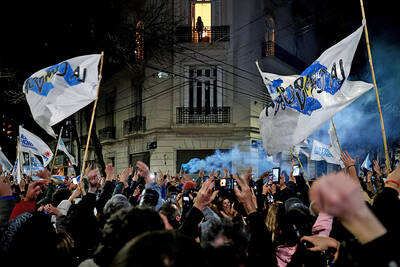Eliminating the millions of tonnes of food thrown away annually in the US and UK could lift more than 1 billion people out of hunger worldwide, experts say.
Government officials, food experts and industry representatives brought together by the Food Ethics Council argue that excessive consumption of food in rich countries inflates prices in the developing world. Buying food, which is then often wasted, reduces overall supply and pushes up the price, making grain less affordable for poor and undernourished people in other parts of the world.
Food waste also costs consumers £10.2 billion (US$16.8 billion) a year and when production, transportation and storage are factored in, it is responsible for 5 percent of the UK’s greenhouse gas emissions.
Tristram Stuart, author of a new book on food waste and a contributor to a special food waste issue of the Food Ethics Council’s magazine, said: “There are nearly a billion malnourished people in the world, but all of them could be lifted out of hunger with less than a quarter of the food wasted in Europe and North America. In a globalized food system, where we are all buying food in the same international marketplace, that means we’re taking food out of the mouths of the poor.”
Food waste in Britain, which totals 6.7 million tonnes a year, costs every household between £250 and £400 a year, figures that are likely to be updated this autumn when the government’s waste agency, Wrap, publishes new statistics. Producing and distributing edible food that goes uneaten and into waste also accounts for 18 million tonnes of carbon dioxide.
But Tom MacMillan, executive director of the Food Ethics Council, said that reducing food waste alone would not be enough to alleviate hunger, because efficiency gains in natural resources were routinely cancelled out by growth in consumption.
“Food waste is harmful and unfair, and it is essential to stop food going into landfill. But the irony is that consumption growth and persistent inequalities look set to undo the good that cutting food waste does in reducing our overall use of natural resources and improving food security,” he said.
MacMillan said the land and resources freed by cutting food waste would probably be put to use producing and consuming other things, such as more resource-intensive and expensive foods, bio-energy or textile crops.
“Now is the moment all parties should be searching out ways to define prosperity that get away from runaway consumption. Until they succeed, chucking out less food won’t make our lifestyles more sustainable,” he said.
In addition to cutting down on waste, experts suggested food waste that does end up in the trash could be dealt with in more environmentally friendly ways.
Paul Bettison, who chairs the UK’s Local Government Association environment board, wrote: “Leftovers are being turned into fertilizer, or gas to generate electricity. In some areas, in-vessel composting and anaerobic digestion are playing a key role in cutting council spending on landfill tax and reducing methane emissions.”
But there were obstacles to generating energy and producing compost from food waste, he said.
“Lack of infrastructure is holding back the drive to make getting rid of food waste cheaper and greener. Councils do not want to collect leftovers without somewhere to send them, but nobody wants to build the places to send food waste until it is being collected,” he said.

LANDMARK CASE: ‘Every night we were dragged to US soldiers and sexually abused. Every week we were forced to undergo venereal disease tests,’ a victim said More than 100 South Korean women who were forced to work as prostitutes for US soldiers stationed in the country have filed a landmark lawsuit accusing Washington of abuse, their lawyers said yesterday. Historians and activists say tens of thousands of South Korean women worked for state-sanctioned brothels from the 1950s to 1980s, serving US troops stationed in country to protect the South from North Korea. In 2022, South Korea’s top court ruled that the government had illegally “established, managed and operated” such brothels for the US military, ordering it to pay about 120 plaintiffs compensation. Last week, 117 victims

China on Monday announced its first ever sanctions against an individual Japanese lawmaker, targeting China-born Hei Seki for “spreading fallacies” on issues such as Taiwan, Hong Kong and disputed islands, prompting a protest from Tokyo. Beijing has an ongoing spat with Tokyo over islands in the East China Sea claimed by both countries, and considers foreign criticism on sensitive political topics to be acts of interference. Seki, a naturalised Japanese citizen, “spread false information, colluded with Japanese anti-China forces, and wantonly attacked and smeared China”, foreign ministry spokesman Lin Jian told reporters on Monday. “For his own selfish interests, (Seki)

Argentine President Javier Milei on Sunday vowed to “accelerate” his libertarian reforms after a crushing defeat in Buenos Aires provincial elections. The 54-year-old economist has slashed public spending, dismissed tens of thousands of public employees and led a major deregulation drive since taking office in December 2023. He acknowledged his party’s “clear defeat” by the center-left Peronist movement in the elections to the legislature of Buenos Aires province, the country’s economic powerhouse. A deflated-sounding Milei admitted to unspecified “mistakes” which he vowed to “correct,” but said he would not be swayed “one millimeter” from his reform agenda. “We will deepen and accelerate it,” he

Japan yesterday heralded the coming-of-age of Japanese Prince Hisahito with an elaborate ceremony at the Imperial Palace, where a succession crisis is brewing. The nephew of Japanese Emperor Naruhito, Hisahito received a black silk-and-lacquer crown at the ceremony, which marks the beginning of his royal adult life. “Thank you very much for bestowing the crown today at the coming-of-age ceremony,” Hisahito said. “I will fulfill my duties, being aware of my responsibilities as an adult member of the imperial family.” Although the emperor has a daughter — Princess Aiko — the 23-year-old has been sidelined by the royal family’s male-only